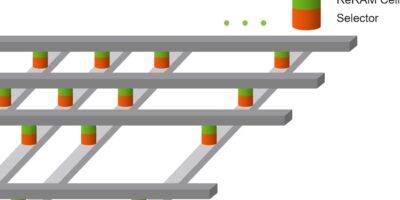Crossbar ReRAM arrays prepare for neuromorphic computing
Development partners CEA-Leti and Weebit Nano have demonstrated the latter’s first operational crossbar arrays. According to the company, it is a key milestone on the company’s path to creating discrete non-volatile memory (NVM) chips.
The 1T1R (one transistor, one resistor) architecture used in embedded ReRAM (Resistive RAM) arrays is not sufficient to support the large arrays of memory cells needed in discrete memory chips. Weebit’s crossbar arrays were developed using a 1S1R (one selector, one resistor) architecture that enables the high density needed for standalone chips. The architecture also allows Weebit’s arrays to be stacked in 3D layers to deliver even higher densities.
The 1S1R crossbar ReRAM architecture has potential applications in storage class memory, persistent memory and as a NOR flash replacement, explained the company. It is also suitable for AI architectures such as in-memory computing and neuromorphic computing.
The company celebrated scaling its ReRAM technology down to 28nm and CEO, Coby Hanoch said the creation of this first kilobit crossbar arrays is a sign of its continued progress for discrete memory solutions.
“Developing such a crossbar array is a very innovative process that requires significant research. As part of this work, we recently filed several new patents together with CEA-Leti, designed to further protect Weebit’s ReRAM intellectual property, with a focus on 1S1R architectures and selector cell programming,” he said.
Weebit Nano develops semiconductor memory technology. The company’s Resistive RAM (ReRAM) addresses the growing need for significantly higher performance and lower power memory solutions in a range of new electronic products such as IoT devices, smartphones, robotics, autonomous vehicles, 5G communications and AI.
The company claims its ReRAM allows semiconductor memory elements to be significantly faster, less expensive, more reliable and more energy efficient than existing flash memory solutions. It is based on fab-friendly materials, meaning the technology can be quickly and easily integrated with existing flows and processes, without the need for special equipment or large investments.




